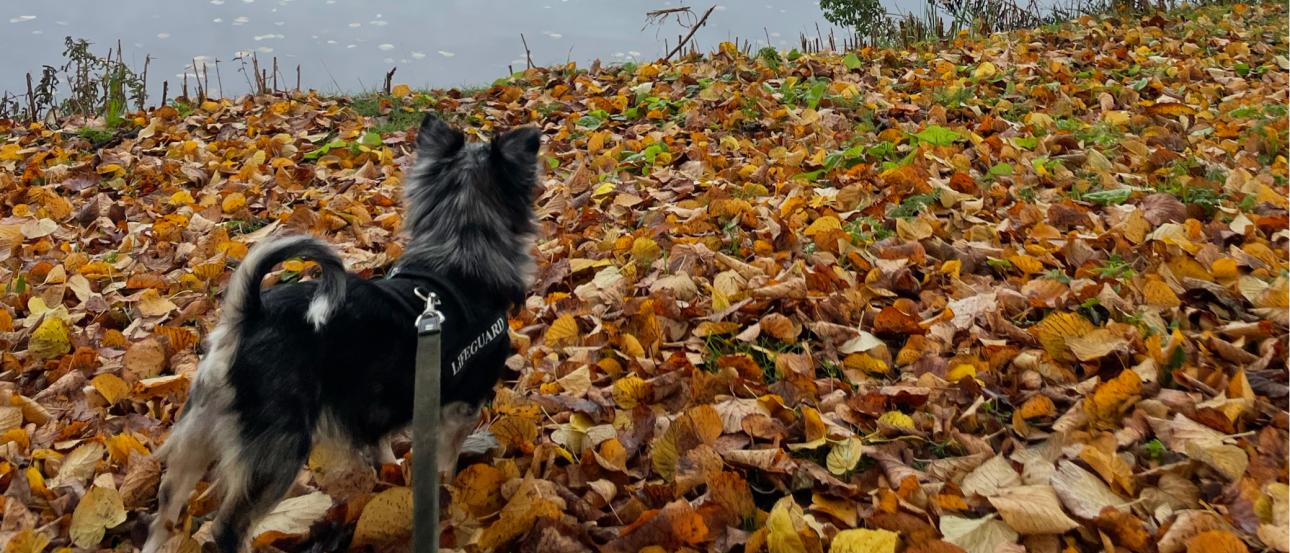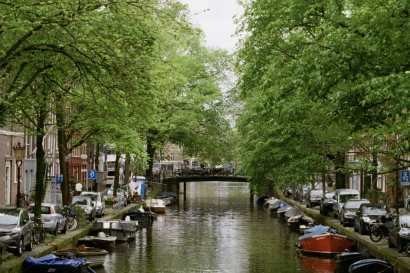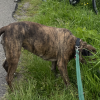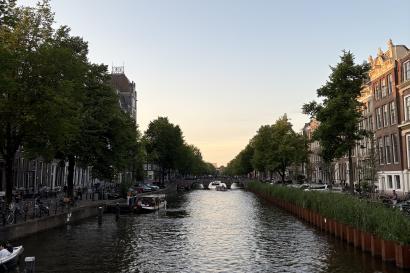Every Friday afternoon, I take the best shower of my life. I wash away the sweat from biking, the rain clogging my hair, the fur and grit under my nails, the dirt covering my body like fine peach fuzz, and most importantly, the smell of the dog kennel. But a few things stay: my joy upon seeing the dogs re-enter their clean kennel (by my and the dogs' standards), met with a fresh bowl of water, a new bowl of food. They sniff and wag their tails and gaze at me with appreciation before shoveling into their neatly blanketed bed. Those images stay and keep me returning every Friday.
I was trained in the masterful art of cleaning dog kennels by a veteran volunteer named Dirk. He’s been volunteering at DOA for three years, so he showed me all the ways to efficiently get the job done in order to maximize cuddle time. The routine is very self-explanatory, essentially hose, soap, rinse, repeat. I make the brisk, early morning bike ride to the shelter, arriving between 8:30 a.m. and 9 a.m. When I get there early enough, the morning dew running down the side of the bright green building looks like leaf veins, and the whole day seems anew, fresh.
After grabbing extra soap bottles from the main building, I head straight to the kennels. I walk past all the stinky, hyper, loud residents, avoiding eye contact with the most anxious, administering chin scratches to the most gentle. I always like to turn on Radio 10 on the computer, which plays a cheesy mix of American and Dutch love songs. It gives me something to sing along to as I scoop poop and rinse stubborn residue. I think it also soothes the dogs in the way classical music or whale sounds calms children. With the help of another volunteer, the dogs are coaxed into their outdoor kennels and I shut the metal dog door behind them. I take on the job cleaning at least three at a time, hauling buckets of soapy water into each kennel like I’m slopping a pig sty, clumps of foam spattering onto the wet cement. The soap used at the shelter is dog friendly and a temporary godsend, as the familiar yet stifling dog stink is replaced by citrus, lavender, cherry blossom. When I go through with the hose, tidal waves of soap, fur, kibble crumbs, and the signature fingernail sized mouse poops, coast under the metal grate into the drain. At least every other Friday, the hose breaks and I’m hit by a jetstream of cold water that soaks my shirt and jeans. If the dogs were inside, I’m sure they’d laugh.
The most satisfying part of cleaning the kennels is easily the squeegee. Everything in the kennels is brown and gray except for the toys and blankets, but there’s nothing more satisfying than watching that brown water run out of the kennel into the drain. Everything really does look more clean. I add the finishing touches; filling up their water bowls, shaking out their blankets. Stinky blankets are taken to the wash. Completely ruined blankets are thrown out. I bask in the sweet soapy scent for a few extra minutes before letting the dogs back inside. Some immediately dive for the food and water. I remember affectionately watching an old Chow Chow, with dreary red eyes and a huge plush cone around his neck, try his very best to get the last of the kibble at the bottom of the bowl. Others go straight for me with teeth anxiously bared. I politely leave them be and let them alone to inspect the new smells. Others don’t even seem to notice the cleaning job; they immediately demand pets and scratches, which I’m more than happy to give in the clean kennels.
Once I’ve finished with the interior kennels, I move on to what Dirk calls, “the toilets”. There isn’t really a good way to describe the “toilets” other than empty, cement kennels connected to the indoor kennels by a metal dog door. A covered walkway runs behind the toilets, which are enclosed with the same metal gates as the indoor kennels. Really, I try not to think about how tight and cell-like these kennels are. Two of the largest dogs up for adoption, both Anatolian Shepherds, the type bred for guarding sheep and fighting wolves, spend most of their time in this cramped space. One of them likes to drag his blankets outside and splay his huge body as far as it will go. The other simply enjoys being outside more than inside. After all, that’s what they’re bred for. Logistically, I know the shelter cannot have enough room for all the dogs to have enough space to run and roam, but I can’t help but imagine what their daily lives would be like if they did.
Cleaning the toilets is much less rewarding, mostly because it is outdoors, muddy, and stinkier if you can believe that. Luckily, it is much faster and, as Dirk put, “They’re dogs and this is their toilet”. So all I need to do is scoop the poop, hose, soap, rinse, and squeegee. The toilets, like the kennels, are also very small. I usually finish everything in two or three hours, leaving enough time to cuddle and walk with my favorites.
I mostly clean the kennels of the dogs who are ready to be adopted, the dogs who are featured on the shelter’s website. I also like working the pension, or the dog hotel, because most of the time, it means I get to meet a new group of dogs every Friday. They’re usually all very friendly and enthusiastic, and their kennels are generally easier to clean since they’re housetrained. Their temperament is usually very sweet, a sad difference from the dogs waiting to be adopted. I remember one Friday I cleaned the last kennel in the pension belonging to a demure gray and white Staffordshire. Her nose was soft like velvet and she acted more like a curious deer than a dog, very slender and dainty as she was. When I was finished, she gave me a sweet lick on the hand and leaned into my pets before curling up in her bed. Within minutes she was dozing, even with the rambunctious barking of her anxious neighbors. I thought, That is the life a dog is supposed to live. She was content, well-fed, warm, attached to her owners who she knew would return. So different from the shelter dogs, who peed in their bed out of stress, who were shut down except for when a volunteer is giving them attention. One day, I came into the kennel of adopting dogs and saw a brown puddle. I turned up my nose in immediate disgust, but then saw the confused, unknowing brown eyes of the puddle maker. I realized he probably feels worse than I do, and all I had to do was hose and bleach it.
I try to save enough time to walk at least two dogs; if not, walk one and give love and attention to another just inside their kennel. One of my favorites is a brindle Staffordshire who has been up for adoption for a long time. She’s small in stature but burly. Even though she is around eight or nine years old, she is a puppy at heart. She’s so good, one of the trainers sometimes lets her run free through the kennels when she’s cleaning. All of the adoption dogs become known for one thing or another among the volunteers. There is a lithe reddish mutt, quiet and polite most of the time, known for combining her athletic ability and excrement to create smeared murals on the walls of the outdoor kennels. A tiny, energetic brown and white Staffordshire, whom I nicknamed “Little Gremlin” for her squat nose and grunting, is known to have stinky paws from dashing back and forth through everything; food, poop, mud. One of the Anatolian Shepherds is a total lover, completely ignorant of his size, and prefers to be as close to you as possible. A smooth coated American Bully, so gentle he wouldn’t hurt a fly, is another favorite of mine, a wholesome golden boy who never says a word. I would take them all home if I could.
One of the all-around favorites of the shelter is a Spanish bulldog with a heart to equal her massive size. Her jowls are sloppy, her eyes equally droopy, and she always insists on consistent pets by softly hitting you with her giant paw. One time, I accidentally locked myself in her kennel while giving her cuddles. Luckily, I was only in there five minutes before I made it out, thanks to another volunteer. Dirk and one of the shelter administrators, also named Emma, told me that, “If you don’t like this dog, you can’t work here”. I do think that what makes her even more special is that despite her stressful situation, being alone in a kennel for the majority of the day, family-less, her sweet nature still shines through. She is the embodiment of all the things we love about dogs, and as I was cuddling with her just the other day, I learned from a trainer she was about to be adopted! “In ten minutes!” the trainer exclaimed. I couldn’t believe it, all I could do was scream with excitement, scooping her wrinkly face into my hands, exclaiming, “You’re getting a home! I’m so happy for you!” She didn’t understand what I was happy about but she felt it, and showed me she was happy too by wagging her tail, bobbing her paws and shoving her head deeper into my hands. I eventually left to walk another dog, a plucky little terrier, giving the bulldog a final kiss that she returned in her messy way. On the way back into the facility with the terrier, I saw a man and his two sons walking the bulldog out the driveway. She was happily plodding along between them, swinging her head from side to side, smelling the air and gazing up at her new family from beneath her hanging eyelids. I called out her name enthusiastically and cheered. The man holding her leash cheered with me, “Dankjewel! Dankjewel!”
Sometimes when I’m soaked in the smell of mud and dog paws, I envy the cat and rabbit volunteers, whose animals and kennels are much cleaner, smaller, drier, and warmer. But then I remember the dogs have no idea about these other living situations. All they know is the dirt and cement and really, when I think about that, I don’t mind making that cement a little less dirty for them. You can just see the goodness in their eyes. They want nothing but for their basic needs of shelter, food, water, and love to be fulfilled. I only see them once a week, which is a small amount of time in the scheme of things. But for them, I bet their whole world is changed when a volunteer arrives and stays a while, showering them with attention, taking them outside to the fields or for a walk around the park. They live for those moments, all while waiting for someone to finally take them to where that love and attention can last forever. As for me, as I said, once a week isn’t a lot, but I look forward to those Fridays every week to give them that until then. And as for my sopping clothes and muddy socks, as they always say, you get wet, and then you get dry.

Emma Basco
My name is Emma Basco and I am originally from Sacramento, California. I am currently studying literature and writing at Sarah Lawrence College in New York. I love to read on the beach, doodle on post it notes, paint with watercolors, and unearth new cafes and restaurants. My hidden talent is that I can make an excellent pot of noodles from packaged ramen.









